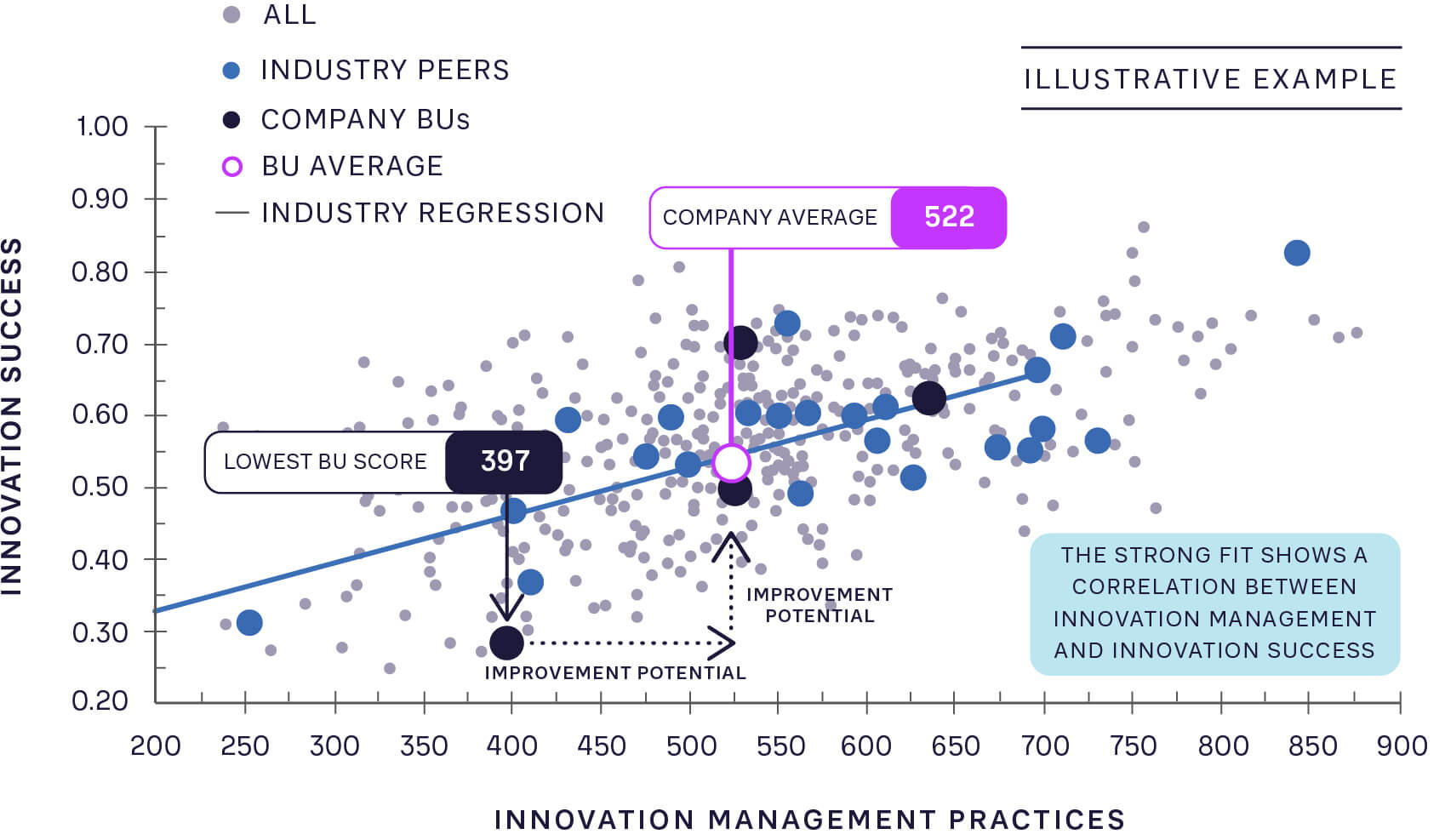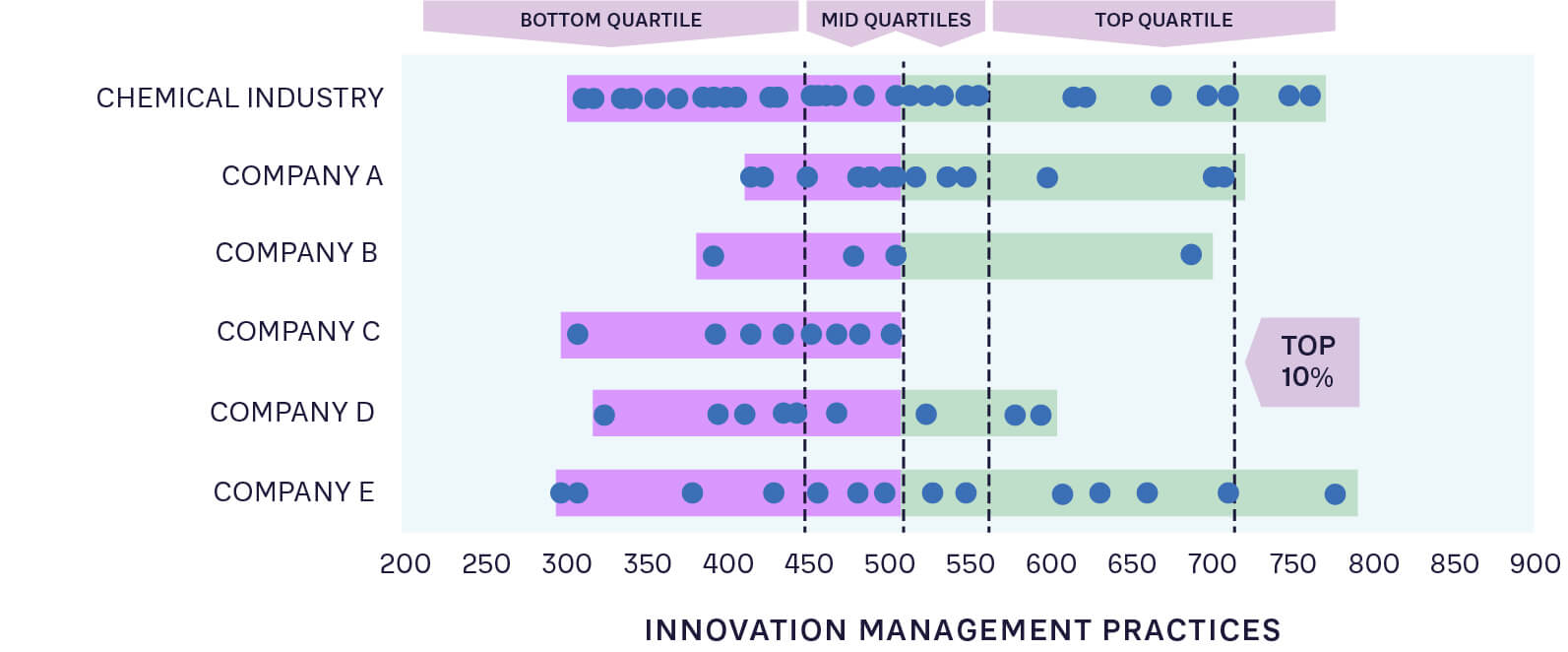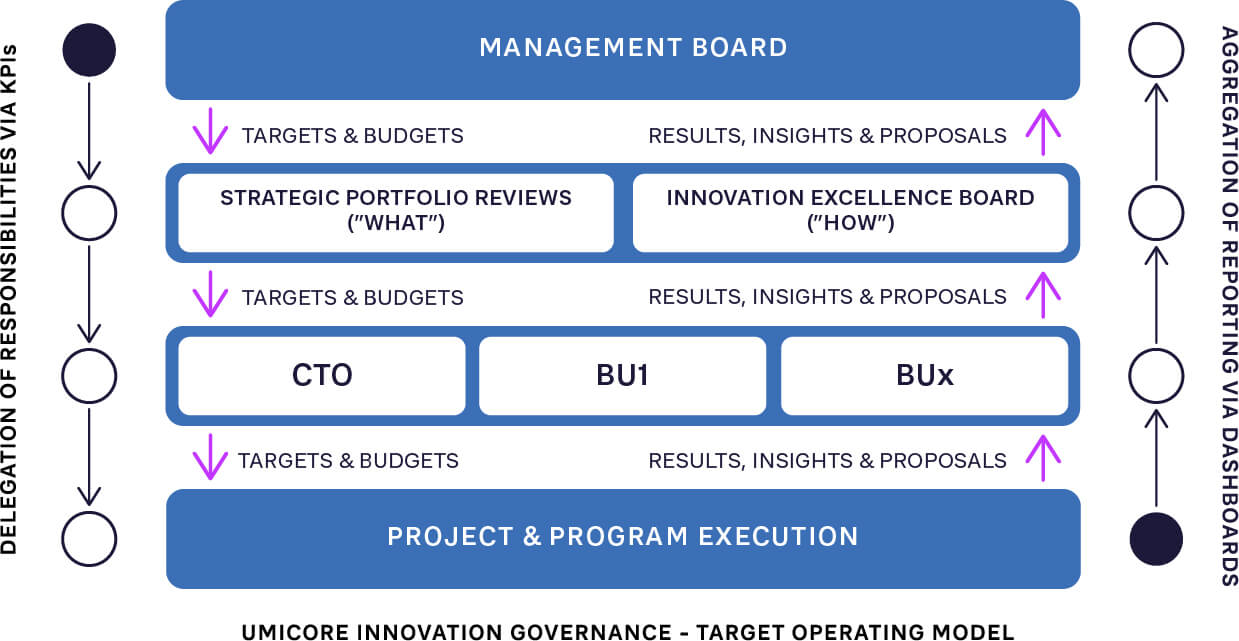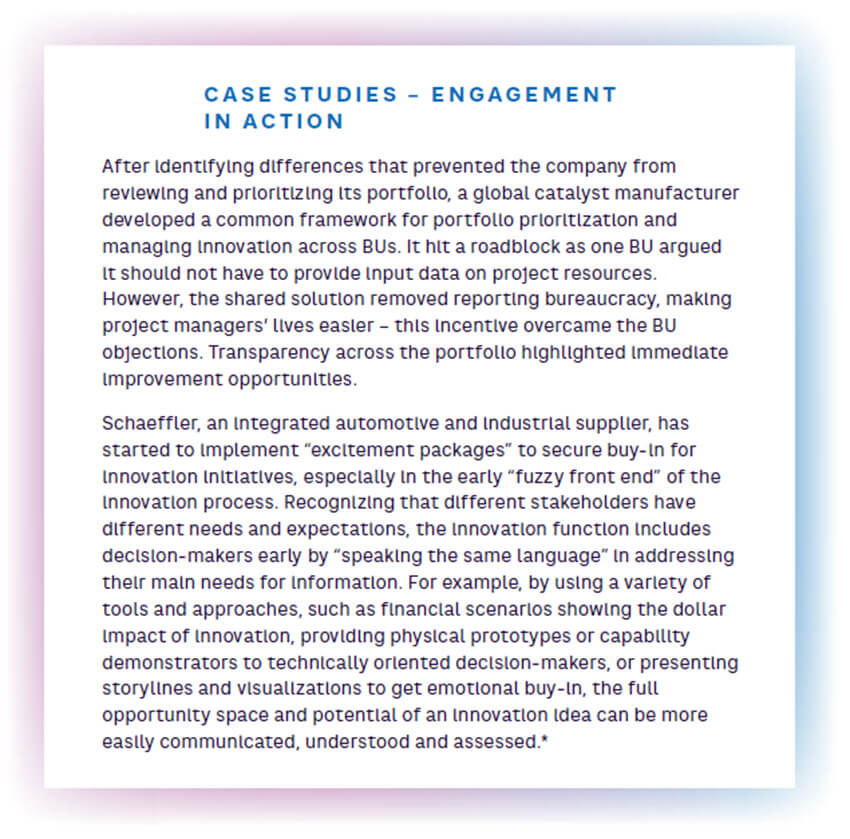7 min read • Technology & innovation management
Closing the innovation gaps between business units
If a business had two similar manufacturing sites that failed to share best practice processes, the chief operating officer would be seen as negligent. Yet, according to our latest research, the same thinking doesn’t seem to apply to sharing innovation best practices, despite its importance for growth and competitiveness.

Why is this, and what can companies do to improve the situation? Based on new research, this article explores the reasons for failure to share best innovation practices between business units and sets out strategic approach companies can take.
About the research
Having run for over 20 years, ADL’s Global Innovation Excellence Benchmark is an anonymous self-assessment best practice database, containing responses from over 500 companies to a series of detailed questions on innovation excellence. It measures two dimensions:
- Innovation success: “What has your innovation effort delivered in terms of business success?”
- Innovation management practices: “How sophisticated are your innovation management practices versus best practice?”
The dataset shows a strong correlation between excellence in innovation management practices and innovation success achieved, as shown in Figure 1. This holds across all industry groups.

For this research, the dataset was further analyzed to identify gaps between innovation management practices across different business units (BUs) in the same company, focusing on the 15 companies that provided this data.
To explore further the innovation gaps and their causes, a dedicated workshop was held with over 50 innovation executives from around the globe.
Demonstrating the innovation gaps
Embedding R&D and innovation centers into decentralized business units is a strategy widely used by large organizations to be more responsive to the needs of the local market and improve the relevance of innovation activities. Typically, such arrangements are complemented by some form of central coordination to ensure that longer-term and breakthrough innovation goals are not neglected in favor of short-term and incremental gains, and that there is some sharing of good practices.
With this type of set-up, one might expect BUs within the same company to adopt similar innovation management practices. However, surprisingly, the data showed that this was not at all the case. The chemical sector provides a good illustration of the gap. (See Figure 2.)

Figure 2 shows that the range of individual BU innovation management excellence scores (the blue dots) is broad within each company. In fact, there is no statistically significant correlation between the performance of BUs within the same company versus BUs across different companies. The data showed similar trends across other industry sectors, so this is not something unique to the chemical sector. These gaps translate into multiple disadvantages, including lower overall innovation performance across the company, duplication of effort, and lack of transparency on innovation approaches across the company.
We calculated that improving the performance of the worst BU to match the company average in each case would lead to 5 percent growth in annual BU revenues, as well as improving margins. If improvements were made within all BUs, significantly higher revenue performances could be expected.
In our subsequent workshop comprising over 50 innovation executives and agents, 78 percent confirmed that standardizing best practices was a challenge and had a negative impact on innovation performance.
Understanding the root causes
Based on analysis, experience, and the views of innovation practitioners, failure to share innovation management best practices has three root causes:
Ineffective leadership and misaligned incentives
Many BU organizational leaders are strongly incentivized on BU-specific goals and revenue targets, and this can make them uncomfortable with the uncertainty and risk associated with incorporating new innovation management practices from other parts of the organization. This is especially a problem if there is no organization-wide governance strategy for innovation management or senior management support for best practice sharing.
“I think the root cause of [not sharing] was that the business unit was so focused and incentivized on its own performance….” — Head of Strategy at Corporate Innovation, global specialty chemicals company
Diversity of needs and aims
BUs want autonomy over innovation and may see organizational best practices as inappropriate for their needs, targets and aims. There may also be variances in innovation clock cycles (i.e., the pace of innovation) and maturity levels between business units, particularly if they are located in multiple geographies or have different heritages, such as having been added by acquisition.
Cultural differences
Individual business units have built up their own cultures and may even compete against other parts of the same organization. Conflicts around power, politics and resources can lead to an insular “not invented here” mentality. This is particularly true if BUs have not been involved in creating innovation management practices. Central management may be seen as out of touch, and sometimes shared language of innovation is lacking across the organization.
“The dominant barrier that leads to a lot of variability across the organization is around politics and the friction of connecting, particularly on a global level.” — Head of R&D at global CPG
Insights for the executive – How to bridge the gaps
These challenges can be overcome, but require a strategic approach, with senior management backing and focusing on three levers:
1. Ensure strong leadership backed by the right incentives
Senior management should first recognize the size of the innovation gaps, and then take an active role in closing them by emphasizing the strategic importance of innovation management best practice to the entire organization and building trust between the BUs. This should be supported by incentives, such as providing access to additional innovation funding for BUs that deploy best practices and meet innovation targets.
Companies then need to create a balanced cross-business unit innovation portfolio with clear plans and protected budgets for short, medium, and long-term innovation targets. Management should set clear expectations for innovation portfolio transparency, including dashboards with board-level monitoring and KPIs.
A good example of this is provided by global materials technology group Umicore. Recognizing that it lacked the data to effectively manage innovation, Umicore established an Innovation Excellence Board to set and monitor innovation results, processes, and insights, and to ensure coaching at all levels to foster adoption and collaboration. (See Figure 3.)
What you cannot measure, you cannot manage....
Umicore’s expectation was that innovation should be everywhere in the company. To achieve this, it recognized that innovation excellence had to become part of the company’s culture. To foster its inclusion in company culture, innovation excellence therefore needed to be part of the company’s innovation governance model.

2. Engage BU stakeholders to enable change
BU stakeholders should be engaged, involved, and listened to, in order to create a sense of ownership around “new” innovation best practices. It is vital to build opportunities for collaboration at all levels by breaking down silos and enabling cross-pollination of ideas through meet-ups, communities and other knowledge-sharing forums. Bringing in influential innovation project leaders from outside can sometimes be effective.
“Most teams focus on solving their problems independently, resulting in islands of success rather than cloning of success. The need is to create the right culture, supported by creative incentivization models that focus on discovering and cloning success, rather than just solving problems in the silos.” — Senior Director Data Sciences, Supply Chain, Innovation at Walmart Global Tech India

*Source: Panel discussion on how to boost innovation and profit through business unit cohesion, EIRMA CTO forum, Wageningen, Netherlands, 2022
3. Build a collaborative, innovation-led structure and culture
As with any successful change initiative, building a cross-BU culture of collaboration requires both top-down and bottom-up approaches to bring teams together. It begins by clearly setting out the overall innovation vision, mission, and objectives for the organization, and understanding what targets the innovation and R&D teams will need to deliver. While objectives, constraints and KPIs will differ across BUs, a common understanding needs to be built about what innovation success looks like, supported by a common language. Involving BUs from the outset is important. A common assessment and benchmarking framework ensure that a credible overall picture can be built to overcome siloed perceptions.
Identification of “soft” levers and understanding the “unwritten rules of the game” that shape the norms and behaviors in each BU is important to remove barriers to sharing. Using an iterative and participative process, trust can be built, and a common prioritized set of initiatives can be identified that has buy-in from both BUs and corporate.
“I think that one key area that we tried to change was to ensure that the ownership for driving innovation was in the business unit, as well as in the technology organization. We also put in place structures that fostered a close dialogue between our technical experts and market experts to build a joint vision for the future.” — Lorraine Phillips, experienced senior director from a supermajor oil and gas company
For many large companies, poor sharing of innovation management best practices is limiting their performance, leaving innovation value on the table. Adopting the right leadership approaches and focusing on BU engagement, trust, and collaboration can make a big difference.

7 min read • Technology & innovation management
Closing the innovation gaps between business units
If a business had two similar manufacturing sites that failed to share best practice processes, the chief operating officer would be seen as negligent. Yet, according to our latest research, the same thinking doesn’t seem to apply to sharing innovation best practices, despite its importance for growth and competitiveness.

DATE

Why is this, and what can companies do to improve the situation? Based on new research, this article explores the reasons for failure to share best innovation practices between business units and sets out strategic approach companies can take.
About the research
Having run for over 20 years, ADL’s Global Innovation Excellence Benchmark is an anonymous self-assessment best practice database, containing responses from over 500 companies to a series of detailed questions on innovation excellence. It measures two dimensions:
- Innovation success: “What has your innovation effort delivered in terms of business success?”
- Innovation management practices: “How sophisticated are your innovation management practices versus best practice?”
The dataset shows a strong correlation between excellence in innovation management practices and innovation success achieved, as shown in Figure 1. This holds across all industry groups.

For this research, the dataset was further analyzed to identify gaps between innovation management practices across different business units (BUs) in the same company, focusing on the 15 companies that provided this data.
To explore further the innovation gaps and their causes, a dedicated workshop was held with over 50 innovation executives from around the globe.
Demonstrating the innovation gaps
Embedding R&D and innovation centers into decentralized business units is a strategy widely used by large organizations to be more responsive to the needs of the local market and improve the relevance of innovation activities. Typically, such arrangements are complemented by some form of central coordination to ensure that longer-term and breakthrough innovation goals are not neglected in favor of short-term and incremental gains, and that there is some sharing of good practices.
With this type of set-up, one might expect BUs within the same company to adopt similar innovation management practices. However, surprisingly, the data showed that this was not at all the case. The chemical sector provides a good illustration of the gap. (See Figure 2.)

Figure 2 shows that the range of individual BU innovation management excellence scores (the blue dots) is broad within each company. In fact, there is no statistically significant correlation between the performance of BUs within the same company versus BUs across different companies. The data showed similar trends across other industry sectors, so this is not something unique to the chemical sector. These gaps translate into multiple disadvantages, including lower overall innovation performance across the company, duplication of effort, and lack of transparency on innovation approaches across the company.
We calculated that improving the performance of the worst BU to match the company average in each case would lead to 5 percent growth in annual BU revenues, as well as improving margins. If improvements were made within all BUs, significantly higher revenue performances could be expected.
In our subsequent workshop comprising over 50 innovation executives and agents, 78 percent confirmed that standardizing best practices was a challenge and had a negative impact on innovation performance.
Understanding the root causes
Based on analysis, experience, and the views of innovation practitioners, failure to share innovation management best practices has three root causes:
Ineffective leadership and misaligned incentives
Many BU organizational leaders are strongly incentivized on BU-specific goals and revenue targets, and this can make them uncomfortable with the uncertainty and risk associated with incorporating new innovation management practices from other parts of the organization. This is especially a problem if there is no organization-wide governance strategy for innovation management or senior management support for best practice sharing.
“I think the root cause of [not sharing] was that the business unit was so focused and incentivized on its own performance….” — Head of Strategy at Corporate Innovation, global specialty chemicals company
Diversity of needs and aims
BUs want autonomy over innovation and may see organizational best practices as inappropriate for their needs, targets and aims. There may also be variances in innovation clock cycles (i.e., the pace of innovation) and maturity levels between business units, particularly if they are located in multiple geographies or have different heritages, such as having been added by acquisition.
Cultural differences
Individual business units have built up their own cultures and may even compete against other parts of the same organization. Conflicts around power, politics and resources can lead to an insular “not invented here” mentality. This is particularly true if BUs have not been involved in creating innovation management practices. Central management may be seen as out of touch, and sometimes shared language of innovation is lacking across the organization.
“The dominant barrier that leads to a lot of variability across the organization is around politics and the friction of connecting, particularly on a global level.” — Head of R&D at global CPG
Insights for the executive – How to bridge the gaps
These challenges can be overcome, but require a strategic approach, with senior management backing and focusing on three levers:
1. Ensure strong leadership backed by the right incentives
Senior management should first recognize the size of the innovation gaps, and then take an active role in closing them by emphasizing the strategic importance of innovation management best practice to the entire organization and building trust between the BUs. This should be supported by incentives, such as providing access to additional innovation funding for BUs that deploy best practices and meet innovation targets.
Companies then need to create a balanced cross-business unit innovation portfolio with clear plans and protected budgets for short, medium, and long-term innovation targets. Management should set clear expectations for innovation portfolio transparency, including dashboards with board-level monitoring and KPIs.
A good example of this is provided by global materials technology group Umicore. Recognizing that it lacked the data to effectively manage innovation, Umicore established an Innovation Excellence Board to set and monitor innovation results, processes, and insights, and to ensure coaching at all levels to foster adoption and collaboration. (See Figure 3.)
What you cannot measure, you cannot manage....
Umicore’s expectation was that innovation should be everywhere in the company. To achieve this, it recognized that innovation excellence had to become part of the company’s culture. To foster its inclusion in company culture, innovation excellence therefore needed to be part of the company’s innovation governance model.

2. Engage BU stakeholders to enable change
BU stakeholders should be engaged, involved, and listened to, in order to create a sense of ownership around “new” innovation best practices. It is vital to build opportunities for collaboration at all levels by breaking down silos and enabling cross-pollination of ideas through meet-ups, communities and other knowledge-sharing forums. Bringing in influential innovation project leaders from outside can sometimes be effective.
“Most teams focus on solving their problems independently, resulting in islands of success rather than cloning of success. The need is to create the right culture, supported by creative incentivization models that focus on discovering and cloning success, rather than just solving problems in the silos.” — Senior Director Data Sciences, Supply Chain, Innovation at Walmart Global Tech India

*Source: Panel discussion on how to boost innovation and profit through business unit cohesion, EIRMA CTO forum, Wageningen, Netherlands, 2022
3. Build a collaborative, innovation-led structure and culture
As with any successful change initiative, building a cross-BU culture of collaboration requires both top-down and bottom-up approaches to bring teams together. It begins by clearly setting out the overall innovation vision, mission, and objectives for the organization, and understanding what targets the innovation and R&D teams will need to deliver. While objectives, constraints and KPIs will differ across BUs, a common understanding needs to be built about what innovation success looks like, supported by a common language. Involving BUs from the outset is important. A common assessment and benchmarking framework ensure that a credible overall picture can be built to overcome siloed perceptions.
Identification of “soft” levers and understanding the “unwritten rules of the game” that shape the norms and behaviors in each BU is important to remove barriers to sharing. Using an iterative and participative process, trust can be built, and a common prioritized set of initiatives can be identified that has buy-in from both BUs and corporate.
“I think that one key area that we tried to change was to ensure that the ownership for driving innovation was in the business unit, as well as in the technology organization. We also put in place structures that fostered a close dialogue between our technical experts and market experts to build a joint vision for the future.” — Lorraine Phillips, experienced senior director from a supermajor oil and gas company
For many large companies, poor sharing of innovation management best practices is limiting their performance, leaving innovation value on the table. Adopting the right leadership approaches and focusing on BU engagement, trust, and collaboration can make a big difference.
